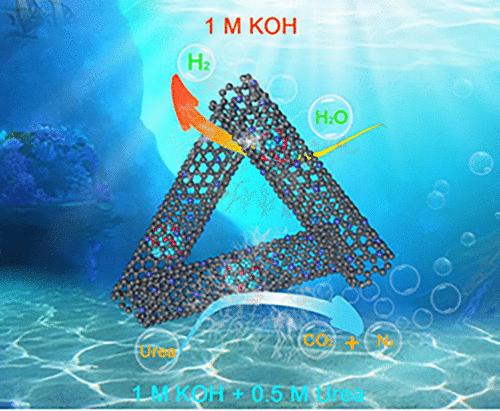掺氮碳纳米管封装的镍活性位点在尿素辅助水电解中的钴掺入促进了二氧化碳解吸
IF 3.9
2区 化学
Q2 CHEMISTRY, MULTIDISCIPLINARY
引用次数: 0
摘要
尿素辅助水电解法在可再生能源基础设施中制氢的潜在应用前景,可有效缓解能源短缺和富尿素废水造成的环境污染。调整镍基电催化剂的二氧化碳解吸能力,克服尿素氧化反应(UOR)的缓慢反应动力学,实现优异的催化活性,具有重要意义。在这项研究中,钴(Co)金属掺杂被用来提高氮掺杂碳纳米管封装镍纳米粒子电催化剂(Ni@N-CNT)的尿素氧化反应性能。系统研究了不同浓度的 Co 掺杂对 UOR 性能和氢进化反应(HER)催化活性及稳定性的影响。掺杂 Co 能有效促进 Ni 向 Ni3+ 物种的动态转化;因此,在 1.6 V vs RHE 条件下,UOR 催化活性提高了 1.8 倍。DFT 计算结果表明,CoNi 双金属结构具有较低的 CO2 吸附结合能,从而加快了限速步骤。同时,掺杂 Co 还提高了 HER 性能,在 100 mA cm-2 条件下,由于产生了更多的活性位点,过电位降低了 57 mV。此外,所组装的尿素辅助水电解装置在电压仅为 1.51 V 时就能达到 10 mA cm-2,而且稳定性极佳。本文章由计算机程序翻译,如有差异,请以英文原文为准。

Cobalt Incorporation Promotes CO2 Desorption from Nickel Active Sites Encapsulated by Nitrogen-Doped Carbon Nanotubes in Urea-Assisted Water Electrolysis
The potential application prospects of urea-assisted water electrolysis toward hydrogen production in renewable energy infrastructure can effectively alleviate energy shortages and environmental pollution caused by rich urea wastewater. It is of prominent significance that adjusting the CO2 desorption of nickel-based electrocatalysts can overcome the slow reaction kinetics for urea oxidation reaction (UOR) to achieve exceptional catalytic activity. In this work, cobalt (Co) metal doping is employed to boost the UOR performance of nitrogen-doped carbon nanotubes encapsulating nickel nanoparticle electrocatalysts (Ni@N-CNT). The influence of diverse Co doping concentrations on the performance of UOR and hydrogen evolution reaction (HER) catalytic activities associated with stability are systematically investigated. The Co dopant can effectively promote the dynamical conversion of Ni to Ni3+ species; as a result, the UOR catalytic activity is improved by 1.8-fold at 1.6 V vs RHE. The DFT calculation results show that the CoNi bimetallic structure possesses a comparably lower binding energy for CO2 adsorption accelerating the rate-limiting step. Meanwhile, the Co dopant also boosts the HER performance, achieving a 57 mV reduction in overpotential at 100 mA cm–2 due to the creation of more active sites. In addition, the assembled urea-assisted water electrolysis attains 10 mA cm–2 at merely 1.51 V as well as excellent stability.
求助全文
通过发布文献求助,成功后即可免费获取论文全文。
去求助
来源期刊

Langmuir
化学-材料科学:综合
CiteScore
6.50
自引率
10.30%
发文量
1464
审稿时长
2.1 months
期刊介绍:
Langmuir is an interdisciplinary journal publishing articles in the following subject categories:
Colloids: surfactants and self-assembly, dispersions, emulsions, foams
Interfaces: adsorption, reactions, films, forces
Biological Interfaces: biocolloids, biomolecular and biomimetic materials
Materials: nano- and mesostructured materials, polymers, gels, liquid crystals
Electrochemistry: interfacial charge transfer, charge transport, electrocatalysis, electrokinetic phenomena, bioelectrochemistry
Devices and Applications: sensors, fluidics, patterning, catalysis, photonic crystals
However, when high-impact, original work is submitted that does not fit within the above categories, decisions to accept or decline such papers will be based on one criteria: What Would Irving Do?
Langmuir ranks #2 in citations out of 136 journals in the category of Physical Chemistry with 113,157 total citations. The journal received an Impact Factor of 4.384*.
This journal is also indexed in the categories of Materials Science (ranked #1) and Multidisciplinary Chemistry (ranked #5).
 求助内容:
求助内容: 应助结果提醒方式:
应助结果提醒方式:


